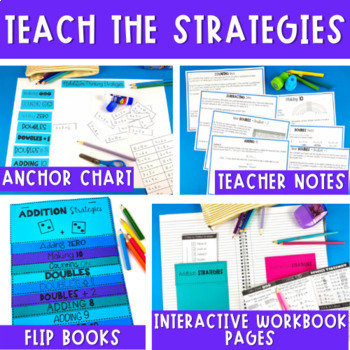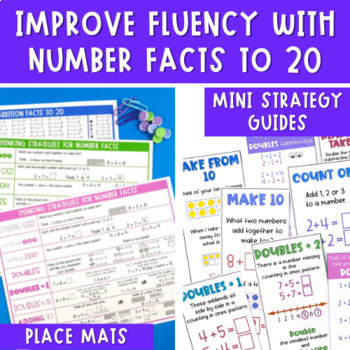Addition and Subtraction for Math Fact Fluency | Adding & Subtracting Math Games
- Zip
What educators are saying
Products in this Bundle (4)
Bonus
Description
Build math fact fluency and practice addition and subtraction strategies with this massive bundle of addition and subtraction games and activities. Perfect for practicing mental math fact strategies, this comprehensive resource focuses on addition and subtraction within 20.
❤️ You'll get a total of 245 addition and subtraction games and activities along with interactive notebook pages and anchor charts to consolidate the number facts and promote math facts fluency in your classroom.
Great for centers and partner work.
The Addition Strategy packs contain:
⇒ Teacher explanation for each strategy.
⇒ Anchor chart headings and number fact strips with instructions.
⇒ A flip book - use as a reference tool for when the class is learning each addition strategy.
⇒ Interactive workbook foldable for using the above strategies. Students answer the number facts on the foldable.
⇒ Interactive workbook pockets for using the above strategies. Students answer the number facts and sort them into the strategy pockets.
⇒ Addition strategies placemat listing the addition mental math strategies and examples.
⇒ 5 colorful addition games (a total of 45 games) which can be used in pairs or small groups for consolidating each of the following strategies:
- Adding 0
- Making 10
- Counting on 1, 2 and 3
- Doubles
- Near doubles (doubles + 1)
- Near doubles ( doubles + 2)
- Adding 8
- Adding 9
- Adding 10
⇒ 5 activities (a total of 60 activities) which can be used independently or in pairs for consolidating each of the following strategies:
- Adding 0
- Making 10
- Counting on 1
- Counting on 2
- Counting on 3
- Counting on 1, 2 and 3
- Doubles
- Near doubles (doubles + 1)
- Near doubles ( doubles + 2)
- Adding 8
- Adding 9
- Adding 10
⇒ 5 activities (a total of 20 activities) which can be used independently or in pairs to consolidate the strategies when ...
- Adding 4
- Adding 5
- Adding 6
- Adding 7
The Subtraction Strategy pack contains:
⇒ Teacher explanation for each strategy.
⇒ Anchor chart headings and number fact strips with instructions.
⇒ A Flip book - use a reference tool for when the class is learning each subtraction strategy.
⇒ Interactive workbook foldable for using the above strategies. Students answer the number facts on the foldable.
⇒ Interactive workbook pockets for using the above strategies. Students answer the number facts and sort them into the strategy pockets.
⇒ Subtraction strategies placemat listing the subtraction mental math strategies and examples.
⇒ 5 colorful subtraction games (a total of 40 games) which can be used in pairs or small groups for consolidating each of the following strategies:
- Subtracting 0
- Counting back 1, 2 and 3
- Count Up
- Subtract from 10
- Doubles Subtraction
- Near Doubles Subtraction
- Subtracting 9
- Subtracting 10
⇒ 5 activities (a total of 55 activities) that can be used independently or in pairs for consolidating each of the following strategies:
- Subtracting 0
- Counting back 1
- Counting back 2
- Counting back 3
- Counting back 1, 2 and 3
- Count Up
- Subtract from 10
- Doubles Subtraction
- Near Doubles Subtraction
- Subtracting 9
- Subtracting 10
⇒ 5 activities (a total of 25 activities) which can be used independently or in pairs to consolidate the strategies when ...
- Subtracting 4
- Subtracting 5
- Subtracting 6
- Subtracting 7
- Subtracting 8
Please note, this resource is licensed for personal use as a single user. It is not to be shared with other teachers, or used by an entire grade level, school or district without purchasing the proper number of licenses.
_______________________________________________________________________
Become a follower and take advantage of my Early Bird Specials...all new products, excluding bundles, will be 50% off for the first 24 hours after being listed.





